Wei Niu
TSLA: A Task-Specific Learning Adaptation for Semantic Segmentation on Autonomous Vehicles Platform
Aug 17, 2025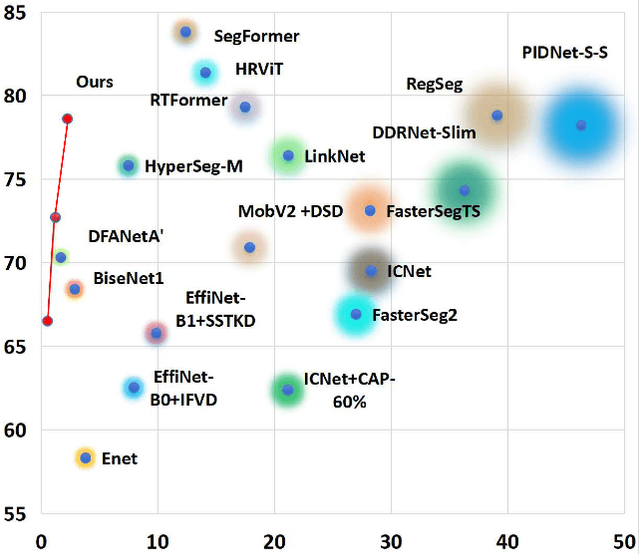
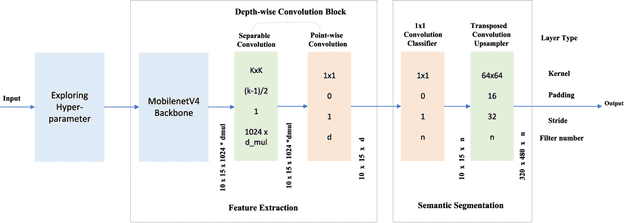
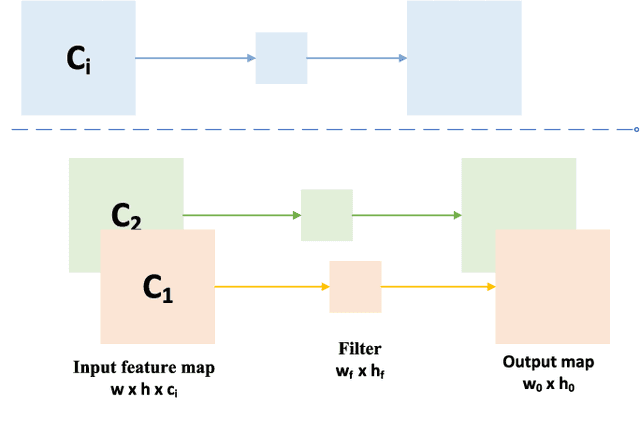
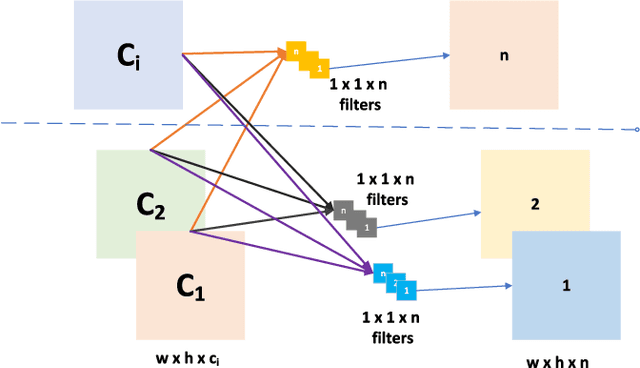
Abstract:Autonomous driving platforms encounter diverse driving scenarios, each with varying hardware resources and precision requirements. Given the computational limitations of embedded devices, it is crucial to consider computing costs when deploying on target platforms like the NVIDIA\textsuperscript{\textregistered} DRIVE PX 2. Our objective is to customize the semantic segmentation network according to the computing power and specific scenarios of autonomous driving hardware. We implement dynamic adaptability through a three-tier control mechanism -- width multiplier, classifier depth, and classifier kernel -- allowing fine-grained control over model components based on hardware constraints and task requirements. This adaptability facilitates broad model scaling, targeted refinement of the final layers, and scenario-specific optimization of kernel sizes, leading to improved resource allocation and performance. Additionally, we leverage Bayesian Optimization with surrogate modeling to efficiently explore hyperparameter spaces under tight computational budgets. Our approach addresses scenario-specific and task-specific requirements through automatic parameter search, accommodating the unique computational complexity and accuracy needs of autonomous driving. It scales its Multiply-Accumulate Operations (MACs) for Task-Specific Learning Adaptation (TSLA), resulting in alternative configurations tailored to diverse self-driving tasks. These TSLA customizations maximize computational capacity and model accuracy, optimizing hardware utilization.
RCR-Router: Efficient Role-Aware Context Routing for Multi-Agent LLM Systems with Structured Memory
Aug 06, 2025Abstract:Multi-agent large language model (LLM) systems have shown strong potential in complex reasoning and collaborative decision-making tasks. However, most existing coordination schemes rely on static or full-context routing strategies, which lead to excessive token consumption, redundant memory exposure, and limited adaptability across interaction rounds. We introduce RCR-Router, a modular and role-aware context routing framework designed to enable efficient, adaptive collaboration in multi-agent LLMs. To our knowledge, this is the first routing approach that dynamically selects semantically relevant memory subsets for each agent based on its role and task stage, while adhering to a strict token budget. A lightweight scoring policy guides memory selection, and agent outputs are iteratively integrated into a shared memory store to facilitate progressive context refinement. To better evaluate model behavior, we further propose an Answer Quality Score metric that captures LLM-generated explanations beyond standard QA accuracy. Experiments on three multi-hop QA benchmarks -- HotPotQA, MuSiQue, and 2WikiMultihop -- demonstrate that RCR-Router reduces token usage (up to 30%) while improving or maintaining answer quality. These results highlight the importance of structured memory routing and output-aware evaluation in advancing scalable multi-agent LLM systems.
Structured Agent Distillation for Large Language Model
May 20, 2025Abstract:Large language models (LLMs) exhibit strong capabilities as decision-making agents by interleaving reasoning and actions, as seen in ReAct-style frameworks. Yet, their practical deployment is constrained by high inference costs and large model sizes. We propose Structured Agent Distillation, a framework that compresses large LLM-based agents into smaller student models while preserving both reasoning fidelity and action consistency. Unlike standard token-level distillation, our method segments trajectories into {[REASON]} and {[ACT]} spans, applying segment-specific losses to align each component with the teacher's behavior. This structure-aware supervision enables compact agents to better replicate the teacher's decision process. Experiments on ALFWorld, HotPotQA-ReAct, and WebShop show that our approach consistently outperforms token-level and imitation learning baselines, achieving significant compression with minimal performance drop. Scaling and ablation results further highlight the importance of span-level alignment for efficient and deployable agents.
QuartDepth: Post-Training Quantization for Real-Time Depth Estimation on the Edge
Mar 20, 2025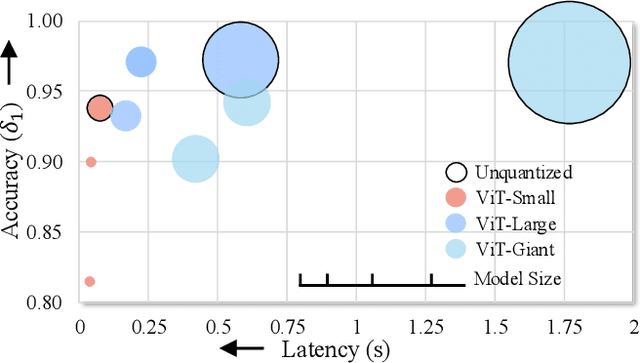
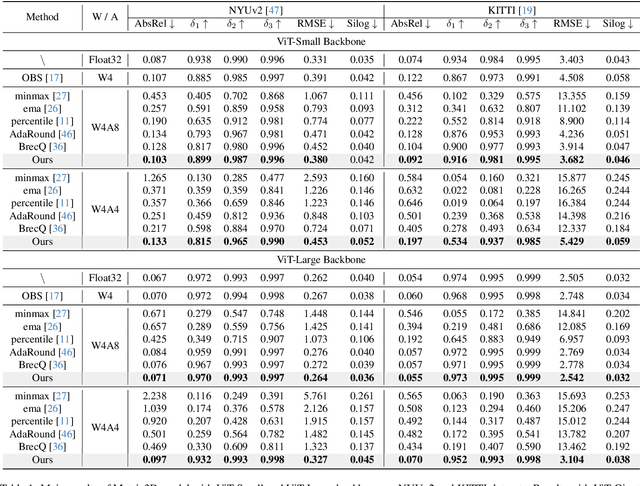
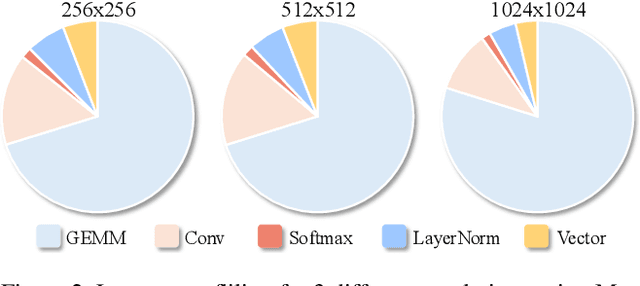

Abstract:Monocular Depth Estimation (MDE) has emerged as a pivotal task in computer vision, supporting numerous real-world applications. However, deploying accurate depth estimation models on resource-limited edge devices, especially Application-Specific Integrated Circuits (ASICs), is challenging due to the high computational and memory demands. Recent advancements in foundational depth estimation deliver impressive results but further amplify the difficulty of deployment on ASICs. To address this, we propose QuartDepth which adopts post-training quantization to quantize MDE models with hardware accelerations for ASICs. Our approach involves quantizing both weights and activations to 4-bit precision, reducing the model size and computation cost. To mitigate the performance degradation, we introduce activation polishing and compensation algorithm applied before and after activation quantization, as well as a weight reconstruction method for minimizing errors in weight quantization. Furthermore, we design a flexible and programmable hardware accelerator by supporting kernel fusion and customized instruction programmability, enhancing throughput and efficiency. Experimental results demonstrate that our framework achieves competitive accuracy while enabling fast inference and higher energy efficiency on ASICs, bridging the gap between high-performance depth estimation and practical edge-device applicability. Code: https://github.com/shawnricecake/quart-depth
Learning LLM Preference over Intra-Dialogue Pairs: A Framework for Utterance-level Understandings
Mar 07, 2025Abstract:Large language models (LLMs) have demonstrated remarkable capabilities in handling complex dialogue tasks without requiring use case-specific fine-tuning. However, analyzing live dialogues in real-time necessitates low-latency processing systems, making it impractical to deploy models with billions of parameters due to latency constraints. As a result, practitioners often prefer smaller models with millions of parameters, trained on high-quality, human-annotated datasets. Yet, curating such datasets is both time-consuming and costly. Consequently, there is a growing need to combine the scalability of LLM-generated labels with the precision of human annotations, enabling fine-tuned smaller models to achieve both higher speed and accuracy comparable to larger models. In this paper, we introduce a simple yet effective framework to address this challenge. Our approach is specifically designed for per-utterance classification problems, which encompass tasks such as intent detection, dialogue state tracking, and more. To mitigate the impact of labeling errors from LLMs -- the primary source of inaccuracies in student models -- we propose a noise-reduced preference learning loss. Experimental results demonstrate that our method significantly improves accuracy across utterance-level dialogue tasks, including sentiment detection (over $2\%$), dialogue act classification (over $1.5\%$), etc.
RoRA: Efficient Fine-Tuning of LLM with Reliability Optimization for Rank Adaptation
Jan 08, 2025



Abstract:Fine-tuning helps large language models (LLM) recover degraded information and enhance task performance.Although Low-Rank Adaptation (LoRA) is widely used and effective for fine-tuning, we have observed that its scaling factor can limit or even reduce performance as the rank size increases. To address this issue, we propose RoRA (Rank-adaptive Reliability Optimization), a simple yet effective method for optimizing LoRA's scaling factor. By replacing $\alpha/r$ with $\alpha/\sqrt{r}$, RoRA ensures improved performance as rank size increases. Moreover, RoRA enhances low-rank adaptation in fine-tuning uncompressed models and excels in the more challenging task of accuracy recovery when fine-tuning pruned models. Extensive experiments demonstrate the effectiveness of RoRA in fine-tuning both uncompressed and pruned models. RoRA surpasses the state-of-the-art (SOTA) in average accuracy and robustness on LLaMA-7B/13B, LLaMA2-7B, and LLaMA3-8B, specifically outperforming LoRA and DoRA by 6.5% and 2.9% on LLaMA-7B, respectively. In pruned model fine-tuning, RoRA shows significant advantages; for SHEARED-LLAMA-1.3, a LLaMA-7B with 81.4% pruning, RoRA achieves 5.7% higher average accuracy than LoRA and 3.9% higher than DoRA.
LazyDiT: Lazy Learning for the Acceleration of Diffusion Transformers
Dec 17, 2024Abstract:Diffusion Transformers have emerged as the preeminent models for a wide array of generative tasks, demonstrating superior performance and efficacy across various applications. The promising results come at the cost of slow inference, as each denoising step requires running the whole transformer model with a large amount of parameters. In this paper, we show that performing the full computation of the model at each diffusion step is unnecessary, as some computations can be skipped by lazily reusing the results of previous steps. Furthermore, we show that the lower bound of similarity between outputs at consecutive steps is notably high, and this similarity can be linearly approximated using the inputs. To verify our demonstrations, we propose the \textbf{LazyDiT}, a lazy learning framework that efficiently leverages cached results from earlier steps to skip redundant computations. Specifically, we incorporate lazy learning layers into the model, effectively trained to maximize laziness, enabling dynamic skipping of redundant computations. Experimental results show that LazyDiT outperforms the DDIM sampler across multiple diffusion transformer models at various resolutions. Furthermore, we implement our method on mobile devices, achieving better performance than DDIM with similar latency.
Open-Source Acceleration of Stable-Diffusion.cpp
Dec 08, 2024



Abstract:Stable diffusion plays a crucial role in generating high-quality images. However, image generation is time-consuming and memory-intensive. To address this, stable-diffusion.cpp (Sdcpp) emerges as an efficient inference framework to accelerate the diffusion models. Although it is lightweight, the current implementation of ggml_conv_2d operator in Sdcpp is suboptimal, exhibiting both high inference latency and massive memory usage. To address this, in this work, we present an optimized version of Sdcpp leveraging the Winograd algorithm to accelerate 2D convolution operations, which is the primary bottleneck in the pipeline. By analyzing both dependent and independent computation graphs, we exploit the device's locality and parallelism to achieve substantial performance improvements. Our framework delivers correct end-to-end results across various stable diffusion models, including SDv1.4, v1.5, v2.1, SDXL, and SDXL-Turbo. Our evaluation results demonstrate a speedup up to 2.76x for individual convolutional layers and an inference speedup up to 4.79x for the overall image generation process, compared with the original Sdcpp. Homepage: https://github.com/SealAILab/stable-diffusion-cpp
AdaCM$^2$: On Understanding Extremely Long-Term Video with Adaptive Cross-Modality Memory Reduction
Nov 19, 2024Abstract:The advancements in large language models (LLMs) have propelled the improvement of video understanding tasks by incorporating LLMs with visual models. However, most existing LLM-based models (e.g., VideoLLaMA, VideoChat) are constrained to processing short-duration videos. Recent attempts to understand long-term videos by extracting and compressing visual features into a fixed memory size. Nevertheless, those methods leverage only visual modality to merge video tokens and overlook the correlation between visual and textual queries, leading to difficulties in effectively handling complex question-answering tasks. To address the challenges of long videos and complex prompts, we propose AdaCM$^2$, which, for the first time, introduces an adaptive cross-modality memory reduction approach to video-text alignment in an auto-regressive manner on video streams. Our extensive experiments on various video understanding tasks, such as video captioning, video question answering, and video classification, demonstrate that AdaCM$^2$ achieves state-of-the-art performance across multiple datasets while significantly reducing memory usage. Notably, it achieves a 4.5% improvement across multiple tasks in the LVU dataset with a GPU memory consumption reduction of up to 65%.
GaussianSpa: An "Optimizing-Sparsifying" Simplification Framework for Compact and High-Quality 3D Gaussian Splatting
Nov 09, 2024



Abstract:3D Gaussian Splatting (3DGS) has emerged as a mainstream for novel view synthesis, leveraging continuous aggregations of Gaussian functions to model scene geometry. However, 3DGS suffers from substantial memory requirements to store the multitude of Gaussians, hindering its practicality. To address this challenge, we introduce GaussianSpa, an optimization-based simplification framework for compact and high-quality 3DGS. Specifically, we formulate the simplification as an optimization problem associated with the 3DGS training. Correspondingly, we propose an efficient "optimizing-sparsifying" solution that alternately solves two independent sub-problems, gradually imposing strong sparsity onto the Gaussians in the training process. Our comprehensive evaluations on various datasets show the superiority of GaussianSpa over existing state-of-the-art approaches. Notably, GaussianSpa achieves an average PSNR improvement of 0.9 dB on the real-world Deep Blending dataset with 10$\times$ fewer Gaussians compared to the vanilla 3DGS. Our project page is available at https://gaussianspa.github.io/.
 Add to Chrome
Add to Chrome Add to Firefox
Add to Firefox Add to Edge
Add to Edge